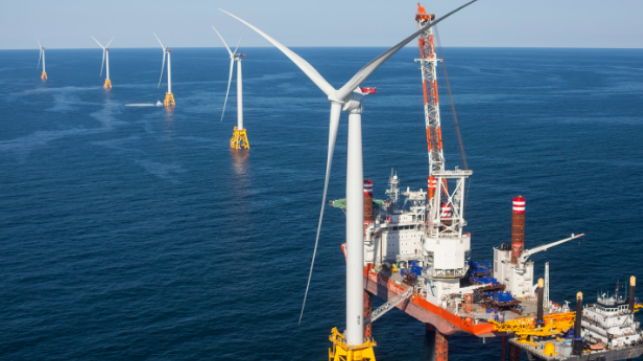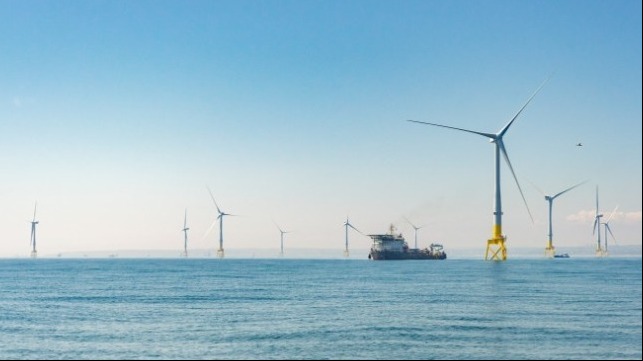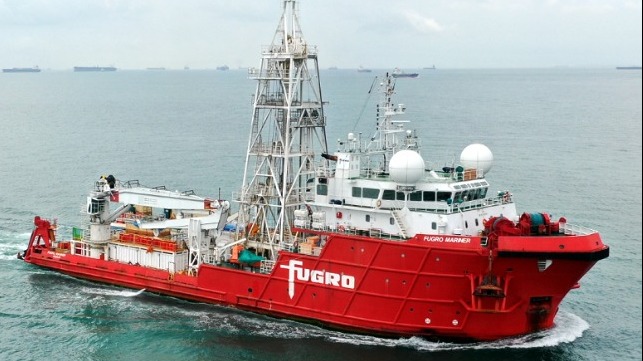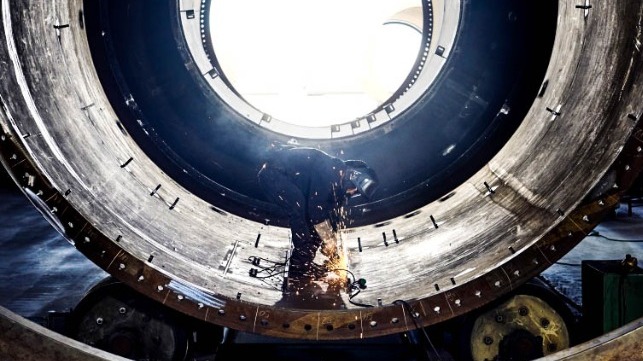Plugging Into the Offshore Wind Industry

In 1965 in Rhode Island, Bob Dylan changed the course of popular music. He scandalized purists by plugging in an electric guitar for the first time in front of an audience at the Newport Folk Festival. It was a bold move that was met with derision by many, but it changed rock and roll forever, and made Dylan a household name. Half a century later, history was made again in Rhode Island as the state’s power grid was plugged in to five wind turbine generators standing in 100 feet of water about 4 miles offshore. It was another bold move, but it forged a connection that would open the door for a whole new wave of offshore wind industry for the United States.
While the European nations and operators have spent the past 30-plus years developing their offshore wind capabilities, the US has lagged behind. Indeed, it was even questioned if the country’s offshore wind plans would ever come to fruition. So, when Rhode Island’s Block Island Wind Farm was built, it sparked excitement and signaled the tangible beginning of a fledgling industry.
By the time Vineyard Wind won Massachusetts’ first offshore wind solicitation in 2018, things had changed. The leading question was no longer a matter of “if” but “when”. A whole new wave of excitement and anticipation was born.
From the earliest days of the now-defunct planned projects off the coasts of Massachusetts and New Jersey, GAC North America has worked diligently to become a trusted partner and leading service provider with the skills and resources the emerging US offshore wind industry needs. We offer guidance to our customers, both foreign and domestic, aiding them in navigating US regulations and requirements for their vessels and personnel working in support of planned wind farms.
Energizing the industry
Initially focusing on vessel agency and husbandry, GAC has worked with vessel owner/operators who previously been based in oilfields in the Gulf of Mexico for years and now needed a trusted guide as they moved to the New England coast for the first time. The company also works with and guides those who had never had a vessel make a US port call, let alone conduct project work in US waters.
Some of its principals are purpose-built to serve the offshore wind industry, while others are significant, long-established players in the upstream Oil & Gas (O&G) sector seeking to expand or diversify and transition into a new market, just as the major construction phases in the US offshore windfarms get underway in the coming years. GAC North America’s experience with all phases of offshore upstream O&G activity give it a solid foundation from which to provide support in every aspect of US offshore wind projects, from initial environmental, geophysical, and geotechnical surveys through to pile or jacket installation, wind turbine generator and substation construction, and inter-array or export cable burial and connection.
In recent years, GAC has been supporting principals working on eight different US offshore wind projects spanning a half-dozen states across the US Northeast and Central Atlantic coastlines. As our principals’ projects progress, they turn to GAC’s multiple business lines to provide additional solutions beyond vessel agency, ranging from in-house customs brokerage, freight forwarding and warehousing to route coordination, visa assistance and optimized bunker fuel supply via GAC Bunker Fuels. In a sign of the times, the company has also provided valuable support in expediting COVID-19 testing and travel coordination, both domestically and internationally. We have added, reassigned or relocated staff as needed to deliver what our customers need, exemplifying the flexibility to serve the industry as efficiently as possible.
Looking forward
Watching this growth and development of our own companies from within is exciting, but it is only a drop in the bucket in comparison to the jobs that offshore wind will bring into the US. Studies from the Bureau of Ocean Energy Management (BOEM) and New York State Energy Research and Development Authority (NYSERDA), among others, predict the offshore wind industry could create more than one hundred thousand US jobs, and generate economic development worth tens of billions of dollars annually. Even before the first monopile or jacket for a commercial windfarm touches the seafloor, we are seeing significant infrastructure investment from private enterprise, cities, and states committing to redeveloping derelict or long-abandoned port terminals – and that means jobs. US-built Crew Transfer Vessels (CTVs) and Service Operation Vessels (SOVs) are putting shipyards to work, US-flagged survey vessels are putting mariners to work, terminal developments and improvements are putting engineers, surveyors, architects, construction crews and more to work.
Beyond the economic benefits, the developing US offshore wind industry has focused further attention on environmental responsibility. Windfarm operators have been working closely with biological and physical oceanographers and local fishing communities to determine the best installation methods and placement of the wind turbine generators to ensure the impacts on migratory fish and bird species are kept to an absolute minimum.
Of particular concern is the protection of the critically endangered North Atlantic right whale. The protection of this species has been factored into the design and operation of new, purpose-built vessels which will support the windfarms on a daily basis after construction. Environmental concerns have also spurred innovation in the propulsion systems of these new vessels, with development in cleaner technologies such as LNG, battery, or hydrogen power becoming more prominent.
GAC North America is now playing a significant role in this expanding industry, in the same way that our colleagues at GAC Denmark did with the first installation at Vindeby in 1991 and GAC UK since the development of North Hoyle and Scroby Sands in the early 2000s. We are drawing on that wealth of experience within the GAC Group to gain insight and support from our colleagues who have already been where we are today. We are also working closely with them as the technology for floating offshore wind becomes more refined, bringing with it the potential for additional US projects in deeper waters. Just a few short years ago, the potential for floating wind turbine generators off the coast of Northern California seemed like a pipedream to some, but now there are already surveys underway in water depths of over 2,000 feet. After all, not so long ago, some of the initial projects planned for the Atlantic coast seemed to be up against insurmountable hurdles, discouraging some visionaries and encouraging many of the nay-sayers, Today, the US has two proof-of-concept wind turbine generators (each of which has a nameplate capacity greater than the first windfarm at Vindeby) in approximately 88 feet of water, 27 miles off the coast of Virginia, ready to enter commercial service.
As states continue to introduce and pass legislation calling for greater environmental responsibility paving the way for renewable energy sources, the US offshore wind industry will continue to grow. Wind turbine generators will continue to get larger and more efficient. Offshore windfarm developments will enter deeper waters and new locales. And the excitement of being not just witnesses, but active participants in a revolutionary period for industry in the United States is something that GAC North America will hold dear in perpetuity.
Adron Allen is business manager for offshore services, oil & gas / renewables at GAC.
The opinions expressed herein are the author's and not necessarily those of The Maritime Executive.
Maritime Research and Offshore Wind Power Investments in UK Green Plan

The UK government announced a broad ten-point plan to lead what the Prime Minister called a “green industrial revolution” that is also designed to create jobs. The investment of more than $5 billion includes portions for the maritime industry and offshore wind power as well as other elements ranging from carbon capture to hydrogen, electric vehicles, and public transportation.
“My Ten Point Plan will create, support, and protect hundreds of thousands of green jobs, whilst making strides towards net-zero by 2050,” said Prime Minister Boris Johnson. “Our green industrial revolution will be powered by the wind turbines of Scotland and the North East, propelled by the electric vehicles made in the Midlands and advanced by the latest technologies developed in Wales, so we can look ahead to a more prosperous, greener future.”
Covering clean energy, transport, nature, and innovative technologies, the Prime Minister said the blueprint would allow the UK to forge ahead with eradicating its contribution to climate change by 2050. Among the more attention-getting elements is a ban on new gasoline and diesel cars in the UK from 2030 to be replaced by electric vehicles, investments to green private homes, expanding nuclear power, and restoring nature with a tree planting initiative.
The maritime industry is included within the overall plan. The Prime Minister said they would invest $26.5 million for “greener maritime.” This would be focused on launching a competition to develop clean maritime technology and include feasibility studies.
Maritime UK Chair, Harry Theochari quickly responded to the announcement welcoming the news of the planned investments. “Given maritime's unique capacity to drive growth and employment at a difficult time for the country, the government is absolutely right to view the sector as critical to meeting the UK’s net-zero ambitions and as an engine of the new green industrial revolution. The market for green maritime technology is truly global, and the first country to make real progress towards maritime decarbonization will reap substantial returns. The new green technologies to move vessels must be matched by green infrastructure at ports, so those vessels can recharge and refuel as people and goods come and go,” Maritime UK said in its statement.
Other elements of the plan will also contribute to the maritime industry. The Prime Minister was to produce enough offshore wind to power every home in the UK. He set a goal of quadrupling the amount of power generated from offshore wind to 40GW by 2030.
He also called for investments in hydrogen and hydrogen technology. The goal is by working with industry to generate 5GW of low carbon hydrogen production capacity by 2030 for industry, transport, power, and homes.
In the field of carbon capture, the Prime Minister wants the UK to become a world-leader in the technology to capture and store harmful emissions away from the atmosphere. The target is to remove 10MT of carbon dioxide by 2030.
In announcing this initiative, which builds on several programs already announced, the Prime Minister said, “this marks the beginning of the UK’s path to net zero, with further plans to reduce emissions whilst creating jobs.
The initiative has sparked much debate and while it has been called a good first step, critics have said it fails to go far enough. They are saying that more investment will be required and bolder initiatives to achieve the goals of reducing carbon emissions and restoring the global environment.
NYK Forms Partnerships to Grow Japan's Offshore Wind Power Sector

The global growth in the offshore wind power sector is contributing to the ongoing investment into the sector. Japan’s NYK Line announced a new partnership to develop opportunities in offshore exploration to further expand its operations in the sector.
NYK announced that it has agreed to a memorandum of understanding with subsidiaries of Fugro headquartered in the Netherlands focusing on geological survey related to offshore wind power generation. NYK and Fugro will undertake a joint study for the operation of an offshore geotechnical investigation vessel and providing a geotechnical service that would contribute to the success of offshore wind projects off Japan.
Japan has been seeking to encourage the development of offshore wind power generation, including legislation in 2019 designed to facilitate the development of new offshore wind projects. While this is expected to spur investments in new projects, the companies noted that before constructing an offshore wind power plant, it is necessary to collect geological data in the sea area when considering the basic design of the wind turbines and the layout of the power plant.
In response to the rapidly increasing demand for undersea ground surveys, a shortage of offshore geotechnical investigation vessels has become apparent in Japan, leading NYK to decide pursue the opportunities. NYK chose to partner with Fugro, which has over 25 years’ experience in the offshore geological survey business in Europe.
The project is exploring the operation of an offshore geotechnical investigation vessel which would conduct a submarine ground survey by performing cone penetration tests, which measures resistance, friction, and water pressure, key data on ground strength necessary in the planning of new offshore installations.
This new partnership is NYK’s latest effort to realize opportunities related to the offshore wind power sector. In January 2020, NYK and Van Oord signed a memorandum of understanding to jointly own and operate offshore wind installation vessels under the Japanese flag. The first vessel, which will have a crane capacity of more than 1,000 mt partners is expected to begin service in 2022.
NYK also announced that it was working with Northern Offshore Group of Sweden to develop a crew transfer vessel business for the offshore wind power generation sector.
Equinor Unveils Proposal for Offshore Wind Plant
at Port of Albany
BY THE MARITIME EXECUTIVE 11-13-2020 05:19:38
Norwegian oil major Equinor has announced new details for a proposal to build an offshore wind tower manufacturing plant at the Port of Albany, New York, in partnership with tower fabricators Marmen and Welcon. It would be the first facility of its kind in the United States.
Marmen and Welcon have already signed an MOU to market their services in the nascent U.S. offshore wind market, which is expected to grow rapidly over the next decade. Their plant would serve the construction of the Equinor/BP Empire Wind and Beacon Wind projects - so long as the New York State Energy Research and Development Authority (NYSERDA) selects their bid in a 2.5 gigawatt offshore wind power solicitation announced earlier this year.
“With this latest solicitation, New York solidifies its commitment to renewable energy and its desire to make the offshore wind industry an important component of the state’s economy,” said Siri Espedal Kindem, President of Equinor Wind U.S. “This plan would create the first facility for offshore wind tower and transition piece manufacturing in the U.S. Our proposal helps secure New York and the Port of Albany as a regional leader in this exciting new industry.”
The tower manufacturing plant would create up to 350 direct jobs around the region, according to Equinor. It would be one element of a multi-port investment project to support Empire Wind, along with improvements at the South Brooklyn Marine Terminal - creating new employment in Upstate and Downstate New York. The extra supply chain activity associated with manufacturing tower components would bring even more economic opportunity to the state, according to Equinor.
“With the ongoing expansion of offshore wind power on the East Coast, the Port of Albany would become a natural destination for future projects to source components. The economic potential for the NY Capital Region is enormous," said Katie Newcombe, the Chief Economic Development Officer for the Center for Economic Growth.
Equinor's Empire Wind lease area is located about 15-30 miles southeast of Long Island, adjacent to the approaches to New York Harbor. The proposed Beacon Wind site is located about 60 miles to the east of Montauk. In September, Equinor announced a deal to sell a 50 percent stake in Empire Wind and Beacon Wind to BP for about $1.1 billion; like other European oil and gas companies, BP has announced plans to rapidly scale up its low-carbon investments, and it is targeting total renewables capex in the range of $5 billion per year.
No comments:
Post a Comment